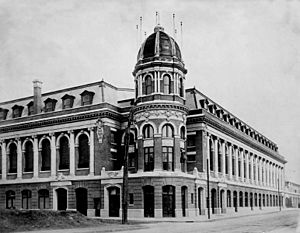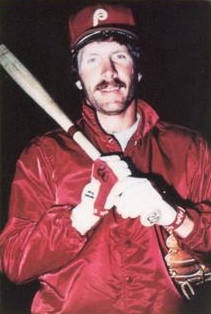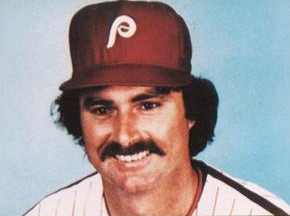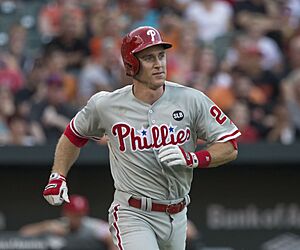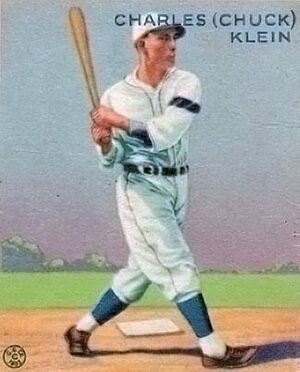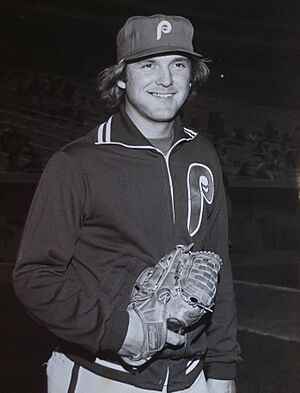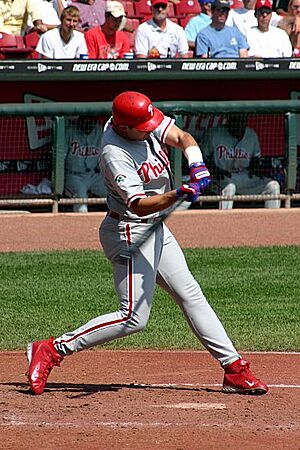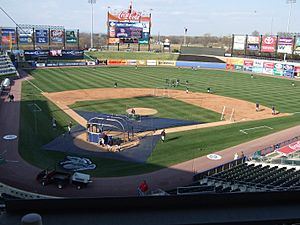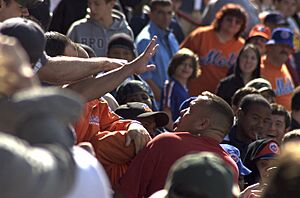Philadelphia Phillies facts for kids
Quick facts for kids Philadelphia Phillies |
|||||
|---|---|---|---|---|---|
|
|||||
|
|||||
| Major league affiliations | |||||
|
|||||
| Current uniform | |||||
| Retired numbers | |||||
| Colors | |||||
|
|||||
| Name | |||||
|
|||||
| Other nicknames | |||||
|
|||||
| Ballpark | |||||
|
|||||
| Major league titles | |||||
| World Series titles (2) |
|
||||
| NL Pennants (8) |
|
||||
| NL East Division titles (12) |
|
||||
| Wild card berths (2) |
|
||||
| Front office | |||||
| Principal owner(s) | John Middleton | ||||
| President | John Middleton (CEO) | ||||
| President of baseball operations | Dave Dombrowski | ||||
| General manager | Preston Mattingly | ||||
| Manager | Rob Thomson | ||||
| Mascot(s) | Phillie Phanatic | ||||
The Philadelphia Phillies are a professional baseball team from Philadelphia, USA. They play in Major League Baseball (MLB) as part of the National League (NL) East Division. Since 2004, their home field has been Citizens Bank Park.
The Phillies started in 1883, making them the oldest team in American professional sports to keep the same name and stay in the same city. They have won two World Series championships: in 1980 against the Kansas City Royals and in 2008 against the Tampa Bay Rays. They have also won eight National League pennants, starting in 1915. The team has played for 142 seasons since 1883.
After 1969, the Phillies became one of MLB's most successful teams. They have made it to the playoffs 15 times and won 12 division titles. This includes winning their division five years in a row from 2007 to 2011.
The team has played in several stadiums in Philadelphia. These include Recreation Park (1883–1886), the Baker Bowl (1887–1938), Shibe Park (1938–1970), Veterans Stadium (1971–2003), and now Citizens Bank Park (2004–present).
Because they have been around for so long, the Phillies were the first American sports team to lose over 10,000 games. However, they are also one of only nine teams to have won over 10,000 games in their history. Many people consider Mike Schmidt, a Hall of Fame third baseman, to be the team's best player ever.
The Phillies have minor league teams that help develop new players. Their top minor league team, the Lehigh Valley IronPigs, plays in Allentown, Pennsylvania.
Contents
- Team History: From Quakers to Phillies
- The Golden Era: World Series Champions Again (2006–2012)
- Team Uniforms
- Team Rivalries
- Team Managers
- Team Achievements
- Minor League Teams
- Radio and Television Broadcasts
- Community Involvement
- See also
Team History: From Quakers to Phillies
Early Days as the Philadelphia Quakers (1883–1889)
In 1883, Al Reach and John Rogers started a new National League team in Philadelphia. This team was meant to replace the Worcester baseball team. The new Philadelphia team was called the "Phillies" from the very beginning. Their first season was tough, with the worst winning record in team history.
In 1884, Harry Wright, a famous manager, joined the team to try and make things better. By 1887, the team moved to a new stadium, which later became known as the Baker Bowl.
Becoming the Phillies (1890–1917)
The name "Phillies" became official on April 3, 1883. It is one of the oldest team nicknames in sports that has been used continuously in the same city.
Great players like Billy Hamilton, Sam Thompson, and Ed Delahanty played for the Phillies during this time. In 1896, Delahanty hit four home runs in one game, a major league record.
When the American League started in 1901, many Phillies players left to join the new league. This made the Phillies struggle, and they finished near the bottom of the standings for several years. In 1903, a balcony at the Baker Bowl collapsed during a game, causing 12 deaths and many injuries.
The Phillies won their first league championship, called a pennant, in 1915. This was thanks to amazing pitching from Grover Cleveland Alexander and strong hitting from Gavvy Cravath. They played in the 1915 World Series against the Boston Red Sox but lost the series four games to one.
In 1917, Alexander was traded away because the team owner, William Baker, did not want to pay him more. This trade hurt the team a lot.
Years of Struggle (1918–1948)
After Alexander left, the Phillies had a very difficult period from 1918 to 1948. They only had one winning season during these 31 years. The team often finished in last place and lost 100 or more games in 12 seasons. This gave the team a reputation for losing.
Some of the team's best players in the 1920s and 1930s were Cy Williams, Lefty O'Doul, and Chuck Klein. Klein won the Triple Crown in 1933, meaning he led the league in batting average, home runs, and runs batted in.
The team's stadium, the Baker Bowl, was not well-maintained and was known for allowing many runs. In 1938, the Phillies moved to Shibe Park, which they shared with the Philadelphia Athletics.
In 1941, the Phillies had their worst season ever, losing 111 games. The team was in financial trouble. In 1943, William D. Cox bought the team, but he was banned from baseball for betting on games. Later that year, Bob Carpenter Sr. and his son, Bob Carpenter, Jr., bought the team. They wanted to improve the team's image.
The Philadelphia Blue Jays (1944–1949)
Before the 1944 season, the team held a contest for a new nickname. They chose "Blue Jays" as an official "additional nickname." However, the name was not popular with fans and was officially dropped in January 1950. Interestingly, the Toronto Blue Jays later used this name when they started playing in 1977.
The Fightin' Phils and the Whiz Kids (1949–1970)
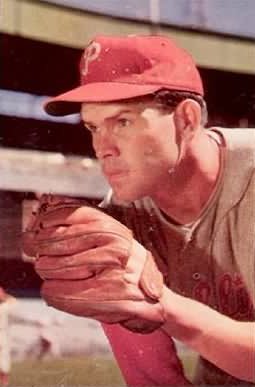

Bob Carpenter Jr. invested money to build a stronger team. The Phillies started to get better in 1949, finishing in third place.
In 1950, the Phillies were called the "Whiz Kids" because they had many talented young players. They led the National League for most of the season. On the last day, Dick Sisler hit a dramatic home run that helped them win their first pennant in 35 years. In the 1950 World Series, they lost to the New York Yankees in four games.
Many thought the Whiz Kids would dominate for years, but the team struggled again. In 1961, the Phillies lost 23 games in a row, which is the longest losing streak in Major League Baseball since 1900.
Things started to improve in 1962 under manager Gene Mauch. In 1964, the team had a strong lead in the pennant race but then lost 10 games in a row, missing the championship. This event is known as the "Phold of '64." A highlight of 1964 was Jim Bunning pitching a perfect game against the New York Mets.
By the late 1950s, the Phillies decided they needed a new stadium. They stayed at Connie Mack Stadium until 1970.
Glory Days and World Series Wins (1971–1984)
The Phillies moved into the new Veterans Stadium in 1971. This stadium was part of the South Philadelphia Sports Complex.
In 1972, Steve Carlton joined the team and won nearly half of their games, earning his first Cy Young Award. With players like Carlton, Mike Schmidt, Larry Bowa, and Greg Luzinski, the Phillies won three division titles in a row from 1976 to 1978. However, they lost in the National League Championship Series each time. In 1979, Pete Rose joined the team, which helped them become even stronger.
1980 World Series Champions
The Phillies won the National League East in 1980. They then had a thrilling NLCS against the Houston Astros, winning in five games.
In the 1980 World Series, the Phillies faced the Kansas City Royals. They won their first World Series championship in six games. Mike Schmidt was named the World Series Most Valuable Player. This win made the Phillies the last of the original 16 MLB teams to win a World Series.
After the 1980 win, the team was sold to a new group of owners. The Phillies returned to the playoffs in 1981 and 1983. In 1983, they reached the World Series again but lost to the Baltimore Orioles. Because of the many older players on the 1983 team, they were nicknamed the "Wheeze Kids."
Rebuilding and the "Macho Row" (1985–2005)
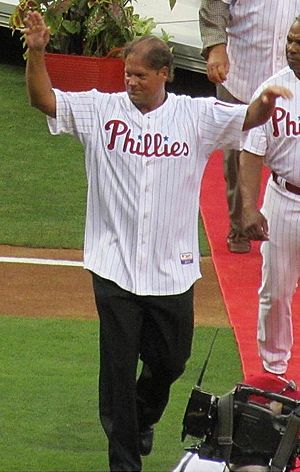
The Phillies had a few tough years after 1984. Star player Mike Schmidt retired in 1989. In 1990, Terry Mulholland pitched a no-hitter.
Before the 1992 season, the team changed their uniforms back to colors similar to the "Whiz Kids" era. In 1993, the Phillies surprised everyone. Led by players like Darren Daulton, John Kruk, Lenny Dykstra, and Curt Schilling, the team was nicknamed "Macho Row" for their tough and unkempt look.
The 1993 Phillies won 97 games and the NL East division title. They beat the Atlanta Braves in the 1993 National League Championship Series to win their fifth NL pennant. However, they lost to the Toronto Blue Jays in the 1993 World Series when Joe Carter hit a game-winning home run in Game 6.
After the 1993 season, many players left, and the team went through a rebuilding phase. They drafted future stars like Scott Rolen, Jimmy Rollins, Pat Burrell, Chase Utley, Ryan Howard, and Cole Hamels. In 2004, the Phillies moved to their new home, Citizens Bank Park.
The Golden Era: World Series Champions Again (2006–2012)
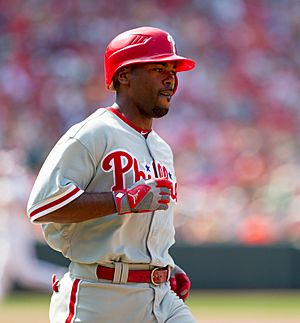
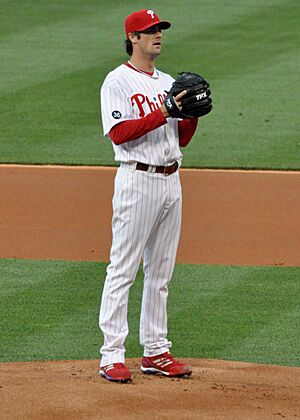

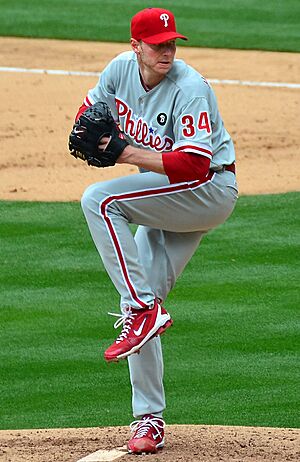
Ryan Howard won the NL Most Valuable Player Award in 2006, and Jimmy Rollins won it in 2007. In 2007, the Phillies won the National League East division title, but lost in the playoffs.
2008 World Series Champions
In 2008, the Phillies won the National League East for the second year in a row. They then defeated the Milwaukee Brewers and the Los Angeles Dodgers in the playoffs. As National League champions, they played the Tampa Bay Rays in the 2008 World Series.
The Phillies won the World Series in five games, bringing their second championship to Philadelphia. Game 5 was unique because it was stopped due to rain and finished two days later. Cole Hamels was named the Most Valuable Player of both the NLCS and the World Series.
The Phillies continued their success in 2009, winning their third straight division title. They reached the World Series again but lost to the New York Yankees.
In 2010, the Phillies acquired star pitcher Roy Halladay. On May 29, 2010, Halladay pitched a perfect game against the Florida Marlins. The Phillies won their fourth consecutive NL East title. In the playoffs, Halladay threw the second no-hitter in MLB postseason history against the Cincinnati Reds. The Phillies swept the Reds but lost to the San Francisco Giants in the NLCS.
Before the 2011 season, the Phillies brought back pitcher Cliff Lee, creating a powerful group of pitchers known as the "Phantastic Phour" or "The Four Aces." This pitching staff was one of the best ever. The Phillies won their fifth straight division championship and set a franchise record with 102 wins. However, they lost to the St. Louis Cardinals in the playoffs.
In 2012, the Phillies had an up-and-down season and missed the playoffs for the first time since 2006.
End of an Era and Rebuilding (2013–2018)
The team struggled in 2013, and manager Charlie Manuel was fired. He was the winningest manager in Phillies history. Pitcher Roy Halladay retired after the season.
In 2014, the team finished last in their division. Key players like Jimmy Rollins and Cliff Lee left the team. In 2015, attendance dropped, and more veteran players like Cole Hamels and Chase Utley were traded. The team continued to rebuild, bringing in new management.
The Phillies finished fourth in their division in 2016. In 2017, manager Pete Mackanin was fired, and Gabe Kapler became the new manager. In 2018, the team started strong but had a late-season collapse, finishing with a losing record.
Building a Winning Team (2019–2022)
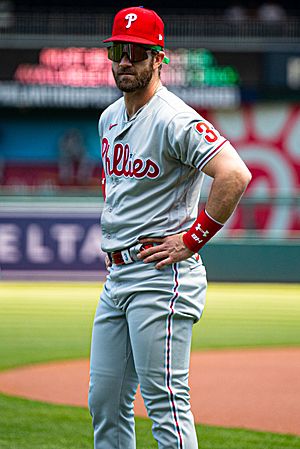
In 2019, the Phillies signed star player Bryce Harper to a big contract. They also added other key players like Jean Segura and J. T. Realmuto. The team started well but then struggled, missing the playoffs. Manager Gabe Kapler was fired.
Joe Girardi became the new manager in October 2019. In the shortened 2020 season, the Phillies again missed the playoffs. New general manager Dave Dombrowski and Sam Fuld were hired to lead the team's baseball operations.
In 2021, the Phillies had their first winning season since 2011, but still did not make the playoffs. Bryce Harper won the NL Most Valuable Player Award. The team signed outfielders Kyle Schwarber and Nick Castellanos to improve their lineup.
The Phillies started the 2022 season slowly. Manager Joe Girardi was fired in June and replaced by Rob Thomson. The team improved greatly under Thomson, finishing with an 87–75 record and reaching the playoffs for the first time since 2011.
In the 2022 postseason, the Phillies beat the St. Louis Cardinals and the Atlanta Braves. They then defeated the San Diego Padres to win the National League Championship Series, with Bryce Harper named MVP. This sent them to the 2022 World Series against the Houston Astros. The Phillies won Game 1 in extra innings and Game 3 with five home runs, a World Series record. However, the Astros won the next three games, taking the series four games to two.
Team Uniforms
Current Uniforms
The Phillies' current uniforms and logo were introduced in 1992. The main colors are red and white, with blue as an accent. The home uniform is white with red pinstripes, while the road uniform is grey. Both have "Phillies" written across the chest. The hats are red with a stylized "P". These uniforms are similar to those worn by the "Whiz Kids" in the 1950s and 1960s.
In 2008, the Phillies added a cream-colored alternate uniform for home day games, honoring their 125th anniversary. This uniform is a throwback to the 1940s. In 2016, a red alternate uniform was added, and in 2017, powder blue throwback uniforms were brought back for special games. In 2024, the Phillies introduced a new "City Connect" uniform, which is light blue and midnight blue with yellow trim, inspired by the flag of Philadelphia.
Patches
The Phillies often wear special patches on their uniforms to honor important events or people. For example, they wore a "2008 World Champions" patch after their win. They have also worn memorial patches for beloved broadcasters like Harry Kalas and former players and owners.
Former Uniforms
From 1970 to 1991, the Phillies wore burgundy and pale blue uniforms with a unique "baseball stitched" P logo. This was the uniform style when they won their first World Series in 1980. This look is still very popular with fans today.
In 1979, the team tried an all-burgundy uniform for Saturday games, but fans and players disliked them, calling them "pajama-like." They were only worn once. In 1994, the Phillies tried all-blue hats for home day games, but players thought they were bad luck, and they were quickly stopped.
Team Rivalries
The Phillies have had several strong rivalries throughout their history, especially against the Atlanta Braves, Los Angeles Dodgers, and New York Mets.
New York Mets
The rivalry between the Mets and Phillies is known as one of the "hottest" in the National League. Both teams are in the NL East division and have often competed for playoff spots.
This rivalry became more intense after 2006, as both teams were strong contenders. Games between them are often very competitive, with passionate fans from both cities.
Pittsburgh Pirates
The rivalry between the Phillies and the Pittsburgh Pirates was once considered one of the best in the National League. Both teams were in the same division from 1969 to 1993 and often won division championships.
After 1994, the Pirates moved to a different division, and the rivalry became less intense. However, older fans still remember the strong competition between the two Pennsylvania teams.
Washington Nationals/Montreal Expos
The Phillies' rivalry with the Washington Nationals goes back to when the Nationals were the Montreal Expos. These teams often battled for control of their division in the 1980s and 1990s.
When the team moved to Washington D.C. in 2005, the rivalry grew due to the cities' closeness. In 2019, when star player Bryce Harper left the Nationals to sign with the Phillies, it added more fuel to the rivalry.
Historical Rivalries: Philadelphia Athletics
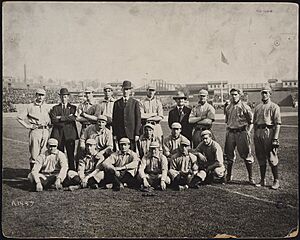
The "City Series" was a special set of games played between the Phillies and the Philadelphia Athletics from 1903 to 1955. The Athletics were another baseball team in Philadelphia. This rivalry ended when the Athletics moved to Kansas City in 1955.
Team Managers
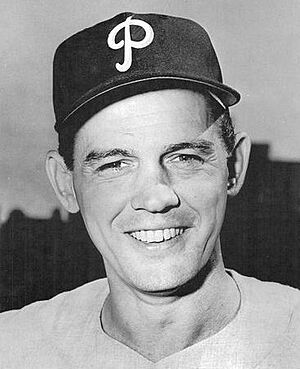

The Phillies have had 55 managers in their history. A manager is like the head coach of the team, making decisions about strategy and leading the players. Danny Ozark and Charlie Manuel each led the team to at least three playoff appearances.
Charlie Manuel and Dallas Green are the only Phillies managers to win a World Series. Green won in 1980, and Manuel won in 2008. Charlie Manuel managed the team for the longest time, from 2005 to 2013.
Team Achievements
Awards
Six Phillies players have won the Major League Baseball Most Valuable Player Award. Mike Schmidt won it three times (1980, 1981, 1986). Other winners include Chuck Klein (1932), Jim Konstanty (1950), Ryan Howard (2006), Jimmy Rollins (2007), and Bryce Harper (2021).
Steve Carlton won the Cy Young Award (for best pitcher) four times (1972, 1977, 1980, 1982). Other Phillies Cy Young winners are John Denny (1983), Steve Bedrosian (1987), and Roy Halladay (2010).
Four Phillies have won the Major League Baseball Rookie of the Year Award: Jack Sanford (1957), Dick Allen (1964), Scott Rolen (1997), and Ryan Howard (2005).
Three Phillies players have hit four home runs in a single game: Ed Delahanty (1896), Chuck Klein (1936), and Mike Schmidt (1976).
Hall of Famers
| Philadelphia Phillies Hall of Famers | |||||||||
|---|---|---|---|---|---|---|---|---|---|
| Affiliation according to the National Baseball Hall of Fame and Museum | |||||||||
|
Retired Numbers and Other Honors
The Phillies have retired eight jersey numbers to honor special players. They also honor five other players with the letter "P" for Phillies. Number 42 was retired across all of Major League Baseball to honor Jackie Robinson.
|
Wall of Fame
The Phillies Wall of Fame honors important players and staff. It started in 1978. Players must be retired and have played at least four years with the Phillies to be considered.
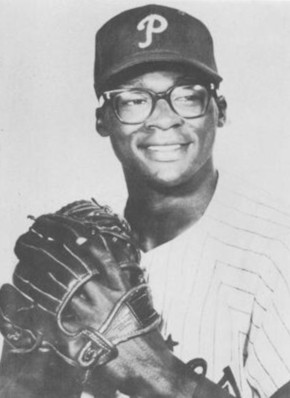
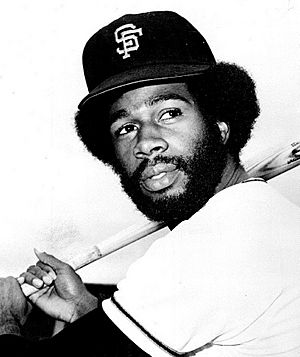
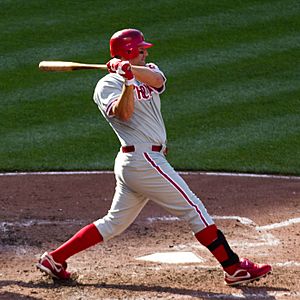
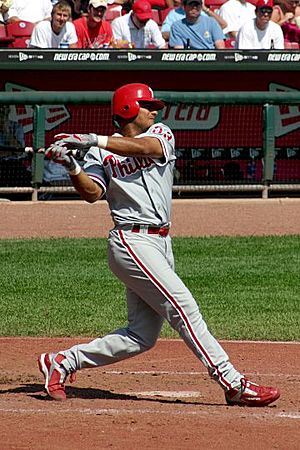
| Member of the National Baseball Hall of Fame and Museum | |
| Bold | Recipient of the Hall of Fame's Ford C. Frick Award |
| Philadelphia Phillies Wall of Fame | |||||
|---|---|---|---|---|---|
| Inducted | Player | Position | Years | Ref | |
| 1978 | Robin Roberts |
P | 1948–1961 | ||
| 1978 | Richie Ashburn |
OF TV |
1948–1959 1963–1997 |
||
| 1979 | Chuck Klein |
OF | 1928–1933 1936–1939 1940–1944 |
||
| 1980 | Grover Cleveland Alexander |
P | 1911–1917 1930 |
||
| 1981 | Del Ennis | OF | 1946–1956 | ||
| 1982 | Jim Bunning |
P | 1964–1969 1970–1971 |
||
| 1984 | Ed Delahanty |
OF | 1888–1889 1891–1901 |
||
| 1985 | Cy Williams | OF | 1918–1930 | ||
| 1986 | Granny Hamner | SS | 1944–1959 | ||
| 1987 | Paul Owens | MGR GM EXEC |
1972, 1983–1984 1972–1983 1984–2003 |
||
| 1988 | Steve Carlton |
P | 1972–1986 | ||
| 1989 | Mike Schmidt |
3B | 1972–1989 | ||
| 1990 | Larry Bowa | SS MGR |
1970–1981 2001–2004 |
||
| 1991 | Chris Short | P | 1959–1972 | ||
| 1992 | Curt Simmons | P | 1947–1960 | ||
| 1993 | Dick Allen |
1B/3B/OF | 1963–1969 1975–1976 |
||
| 1994 | Willie Jones | 3B | 1947–1959 | ||
| 1995 | Sam Thompson |
OF | 1889–1898 | ||
| 1996 | Johnny Callison | OF | 1960–1969 | ||
| 1997 | Greg Luzinski | OF | 1970–1980 | ||
| 1998 | Tug McGraw | P | 1975–1984 | ||
| 1999 | Gavvy Cravath | OF MGR |
1912–1920 1919–1920 |
||
| 2000 | Garry Maddox | OF | 1975–1986 | ||
| 2001 | Tony Taylor | 2B | 1960–1971 1974–1976 |
||
| 2002 | Sherry Magee | OF | 1904–1914 | ||
| 2003 | Billy Hamilton |
OF | 1890–1895 | ||
| 2005 | Bob Boone | C | 1972–1982 | ||
| 2006 | Dallas Green | P MGR |
1960–1967 1979–1981 |
||
| 2007 | John Vukovich | INF CO EXEC |
1970–1971, 1976–1981 1988–2004 2004–2007 |
||
| 2008 | Juan Samuel | 2B CO |
1983–1989 2011–2017 |
||
| 2009 | Harry Kalas |
TV | 1971–2009 | ||
| 2010 | Darren Daulton | C | 1983 1985–1997 |
||
| 2011 | John Kruk | 1B TV |
1989–1994 2017–present |
||
| 2012 | Mike Lieberthal | C | 1994–2006 | ||
| 2013 | Curt Schilling | P | 1992–2000 | ||
| 2014 | Charlie Manuel | MGR CO |
2005–2013 2019 |
||
| 2015 | Pat Burrell | OF | 2000–2008 | ||
| 2016 | Jim Thome |
1B | 2003–2005, 2012 | ||
| 2017 | no inductees–see Pete Rose | ||||
| 2018 | Pat Gillick |
GM EXEC |
2005–2008 2008–present |
||
| Roy Halladay |
P | 2010–2013 | |||
| 2019 | Bobby Abreu | OF | 1998–2006 | ||
| 2020 | Manny Trillo | 2B | 1979–1982 | ||
| 2022 | Bake McBride | RF/CF | 1977–1981 | ||
| Ron Reed | P | 1976–1983 | |||
| 2023 | Ruly Carpenter | EXEC | 1963–1981 | ||
| John Quinn | GM | 1959–1972 | |||
| Scott Rolen |
3B | 1996–2002 | |||
| 2024 | David Montgomery | EXEC | 1971–2019 | ||
| 2025 | Jimmy Rollins | SS | 2000–2014 | ||
| Ed Wade | GM | 1998–2005 | |||
Centennial Team
In 1983, the Phillies chose their Centennial Team, honoring the best players from the first 100 years of the franchise.
| List of players honored as Centennial Team members | |
| Player | Position |
|---|---|
| Richie Ashburn |
CF |
| Bob Boone | C |
| Larry Bowa | SS |
| Steve Carlton |
LHP |
| Garry Maddox | CF |
| Dallas Green | MGR |
| Jim Konstanty | RHP |
| Del Ennis | OF |
| Tug McGraw | LHP |
| Robin Roberts |
RHP |
| Pete Rose | 1B |
| Mike Schmidt |
3B |
| Manny Trillo | 2B |
Minor League Teams
The Phillies have a system of minor league teams where young players develop their skills. They have seven minor league teams at different levels.
| Class | Team | League | Location | Ballpark | Affiliated |
|---|---|---|---|---|---|
| Triple-A | Lehigh Valley IronPigs | International League | Allentown, Pennsylvania | Coca-Cola Park | 2008 |
| Double-A | Reading Fightin Phils | Eastern League | Reading, Pennsylvania | FirstEnergy Stadium | 1967 |
| High-A | Jersey Shore BlueClaws | South Atlantic League | Lakewood, New Jersey | ShoreTown Ballpark | 2001 |
| Single-A | Clearwater Threshers | Florida State League | Clearwater, Florida | BayCare Ballpark | 1985 |
| Rookie | FCL Phillies | Florida Complex League | Carpenter Complex | 2021 | |
| DSL Phillies Red | Dominican Summer League | Santo Domingo, Distrito Nacional | Philadelphia Phillies Complex | 2017 | |
| DSL Phillies White |
Radio and Television Broadcasts
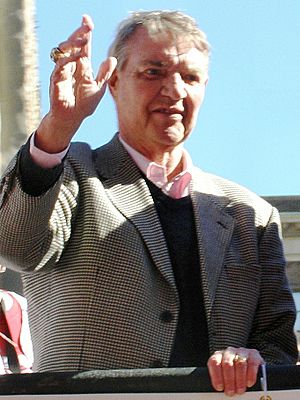
The Phillies' games are broadcast on radio and television. The main radio station is WIP-FM (94.1 FM). Scott Franzke is the play-by-play announcer on the radio.
For television, games are shown on NBC Sports Philadelphia and WCAU (NBC Channel 10). Tom McCarthy calls the play-by-play for TV.
Famous past broadcasters include Harry Kalas, who was known for his "That ball is outta here!" home run call. After his death, the Phillies honored him by naming a restaurant and the TV broadcast booth after him. When the Phillies win at home, his recording of "High Hopes" is played.
The Phillies' public-address announcer at Citizens Bank Park is Dan Baker, who has been with the team since 1972.
Community Involvement
Charitable Contributions
Since 1984, the Phillies have supported research for amyotrophic lateral sclerosis (ALS), also known as Lou Gehrig's disease, through their "Phillies Phestival." This event has raised over $10 million for ALS research.
Education Programs
The Phillies have programs to encourage reading and learning. "Phanatic About Reading" encourages kids to read, and "Phillies Phundamentals" uses baseball to make learning fun.
Fan Support and Reputation
Phillies fans are known for being very passionate and sometimes a bit rowdy. They are famous for cheering loudly for their team and sometimes for heckling opposing players.
The team's mascot is the Phillie Phanatic, who is very popular and known as "baseball's best mascot." He was introduced in 1978. Before him, the team had mascots named Philadelphia Phil and Phyllis, who were not as popular.
Phillies fans are very loyal. Since moving to Citizens Bank Park, the team has often sold out games and had high attendance numbers.
See also
 In Spanish: Philadelphia Phillies para niños
In Spanish: Philadelphia Phillies para niños






